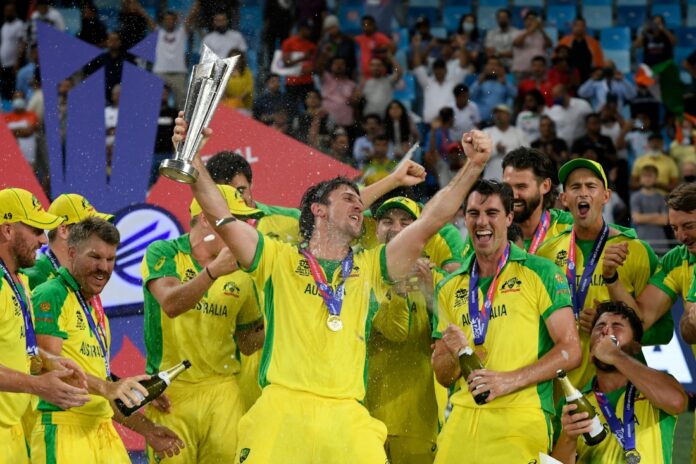Many years ago, I played in a Sunday football team run by a respected sportswriter. On occasions, we were joined by another respected sportswriter and the two would occupy the full-back positions. One Sunday, a young winger was running the left-back ragged, to the extent that an old hamstring injury befell him. As he hobbled off, the right-back uttered the unsympathetic words of “strengthened by injury, yet again.”
This was not the case for England’s T20 cricket team in its World Cup semi-final last week. The injuries to one of its rampaging opening batters and one of its key “death” bowlers, someone who is effective at keeping runs down at the end of the opponent’s innings, left gaps that proved hard to fill in the semi-final. The victors, New Zealand, were worthy winners, implementing their plans in a meticulous, efficient and, ultimately, explosive fashion.
Thus, England’s hopes of being world champions in both white-ball formats of 20 and 50 overs were dashed by opponents who had suffered cruelly at the hands of England in the 50-over World Cup final in 2019. New Zealand’s hopes of redemption were then shattered in the T20 final by none other than their neighbors, Australia, who had shocked Pakistan in the other semi-final.
Chasing 172 to win in that match, Australia had stumbled to 96 for five, with one Pakistani bowler claiming four wickets for 24 runs. Remarkably, Australia did not lose another wicket, securing victory with an over to spare. At the outset of the tournament, the team did not appear to be in good shape, having suffered recent series defeats, had a coach under pressure, been accused of outdated tactics and a squad comprising some out-of-form or out-of-practice players. This showed in the early matches, including a trouncing by England. In contrast, Pakistan had won all their matches in convincing style. This makes Australia’s turnaround even more impressive.
In the group stage, Australia secured a semi-final place by virtue of having a superior net run rate of 0.477 over South Africa, both having eight points. This is a narrow margin, leading to questions being asked about its suitability. It is not easy to understand or follow, particularly at a time when administrators are trying to make the game accessible to new audiences.
In straightforward terms, the rate calculates how many more runs a team scored per over compared with its opponents, averaged over the whole tournament or individual stage. In tournaments with few matches, there can be wild swings from match to match that can distort the overall rate. The number of wickets that fall is considered to be irrelevant. This, for some people, ignores the essence of cricket; the delight for a bowler of taking a wicket, of outfoxing the opponent holding the bat. In limited overs matches, a team can win without taking a wicket. The role and skill of the bowler is to minimize the number of runs scored, with wickets a bonus. In the final matches of the 2021 Super 12 stage, captains who won the toss made decisions to bowl first in an attempt to boost their net run rate. This was a factor that helped Australia.
However, the captain has to win the toss. Out of seven tosses, the Australian captain won six and won all those matches chasing. This was a particular advantage given the conditions of play, especially for matches that commenced at 6.30 p.m. UAE time, under floodlights. By the time the second innings opened, dew had formed. This makes it harder for bowlers to grip and spin the ball, which can more easily slip out of the hand, offering advantage to those batting. Bowling with a wet ball can be akin to trying to bowl with a wet bar of soap.
Thus, the conditions in the UAE made the toss a bigger factor than ideal. In the 32 matches played from the Super 12 stage onwards, 21 were won by the team batting second, with 11 of the 12 contests played in Dubai won by the team chasing. The clear importance of winning the toss was a flaw in the tournament, although the team batting second still has to achieve its victory. Australia dug very deep to lift the trophy with a team that grew in unity through the tournament. The next T20 World Cup is scheduled for October and November 2022, in Australia. Its team will surely be installed as favorites to retain the title.
Playing conditions will be different and, presumably, there will be no changes to the use of net run rate. Statisticians have generated some alternatives, but the current method is preferred. One easy-to-understand alternative would be the use of bonus points for runs scored and wickets taken.
After 2022, a T20 World Cup tournament is scheduled every other year up to and including 2030, comprising 20 teams from 2024. This frequency, coupled with the expansion of the Indian Premier League, the possibility of a second in-year IPL event and high-profile tournaments in other Test-playing countries, means that the T20 format is becoming ever more pervasive within the calendar of cricket.
It is also a route into international cricket for emerging nations so, by 2030, it may well have become the dominant format. Without doubt, it is where the money and the power lie, given the Board of Control for Cricket in India’s stranglehold via the IPL. In turn, this provides it with levers of power within the game’s governing body, the International Cricket Council. In defense of this position, the Indian view is that it generates revenue that can be widely distributed to sustain the game.
This assumes levels of responsible governance that have not always been in evidence. The recent revelations of racism in English cricket have highlighted inept and inappropriate governance. These magnify an impression that cricket is unable to protect itself from self-inflicted injuries. Will its response to the crisis strengthen the game, yet again?

